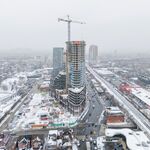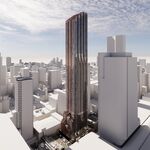W
wyliepoon
Guest
Link to article
Prisoners of desire
905ers embrace the idea of urbanity and the fact of suburbanism ... not exactly a formula for change
Kelvin Browne
National Post
Saturday, July 08, 2006
Kelvin Browne, who writes frequently on architecture for the Post Homes section, asks whether Toronto's suburbanites really do have the appetite for more urban environs.
All of a sudden pedestrian-friendly planning is a 905 priority. Sidewalks are in, wide roads out and cul-de-sacs are considered dead ends. Mixed use is no longer a dirty word.
Will this lead to more livable 905 cities, cities like (dare I say) Toronto? Or is it too little, too late, especially if implemented badly?
We hope for the best. Acres of suburban houses with cars as their only lifeline to a grocery store, school or office are depressing. Big residential towers set in pseudo parks remote from most everything don't generate social statistics we like. Yet we've known a car-tyrannized suburb is not the best place to live for a decade. What's changed?
For one thing, Toronto's downtown is increasingly populated and interesting, with new cultural buildings creating a fascinating urban environment. The 905 is looking decidedly unchic by comparison. Image aspirations have changed from the suburban to urban ideal. This is where discontent begins.
905ers know they live and work there because it offers cheaper housing, inexpensive commercial space compared to the core and huge, single-level warehouses not found anywhere else. Schools seem to be nicer. There's less traffic on residential streets. Everything is just steps from their cars. For this, they do more driving and ignore jokes about Scarberia or wherever. That is the bargain.
The 905ers say they want to live in a more urban environment. What's meant is they want exactly what they have now but with a real downtown a few blocks from their bungalows. They want charming corner stores and nearby transit that whisks them to cultural facilities and the vibrancy of non-shopping-mall amusement.
But they show no evidence of being willing to pay the price for it. Proof? The lack of money for, and use of, mass transit; the continued endorsement of low-rise single-family development at suburban densities; and planning restrictions that otherwise maintain the status quo.
A second issue is what to do with the concrete memories of the bad old days when walking and bikes were socialist fads: wide roads, isolated towers in seas of asphalt parking lots, vast tracts of houses whose meandering street patterns make intensification difficult. The 905 has to reverse its evolution and fill in. More importantly, it has to change the spine its built form hangs on if anything resembling a real city is to emerge. If not, it will merely have better-designed buildings and cute pockets of Disney-esque urbanity. It will be like Los Angeles.
Government supported suburbanization by passively acquiescing to it. Imposing urbanity is much harder than letting the road of least resistance be travelled, particularly when developers who build tract houses are enormous contributors to politicians' election campaigns.
Most large-scale impositions of urbanity, except perhaps for Baron Haussmann's remake of Paris, are failures. Think of boring new British towns; Brasilia; Le Corbusier's Chandigarh, India; Celebration, Fla.; or those well-meaning attempts at social reprogramming such as Regent Park and St. Jamestown. Jane Jacobs's distrust of any government's imposition on the urban landscape is justified. If the 905 is to change from banal to beautiful, government can allow it to happen but that's about all it can do.
Only popular support and incremental, private-sector initiatives will bring urbanity to the 905.
I can't wait for pretty suburban neighbourhoods to beg to be intensified (''Double my density, please''), for apartments to be built in their midst and for nearby streets to gain several storeys of commercial and retail space, for people to happily take transit when they can drive, or shop on a main street instead of paying less at the box store. Until then, you'll get a lot of bureaucrats saying trendy things about cities while developers continue to build endless subdivisions, more strip malls and everything else that people want, but shouldn't.
Prisoners of desire
905ers embrace the idea of urbanity and the fact of suburbanism ... not exactly a formula for change
Kelvin Browne
National Post
Saturday, July 08, 2006
Kelvin Browne, who writes frequently on architecture for the Post Homes section, asks whether Toronto's suburbanites really do have the appetite for more urban environs.
All of a sudden pedestrian-friendly planning is a 905 priority. Sidewalks are in, wide roads out and cul-de-sacs are considered dead ends. Mixed use is no longer a dirty word.
Will this lead to more livable 905 cities, cities like (dare I say) Toronto? Or is it too little, too late, especially if implemented badly?
We hope for the best. Acres of suburban houses with cars as their only lifeline to a grocery store, school or office are depressing. Big residential towers set in pseudo parks remote from most everything don't generate social statistics we like. Yet we've known a car-tyrannized suburb is not the best place to live for a decade. What's changed?
For one thing, Toronto's downtown is increasingly populated and interesting, with new cultural buildings creating a fascinating urban environment. The 905 is looking decidedly unchic by comparison. Image aspirations have changed from the suburban to urban ideal. This is where discontent begins.
905ers know they live and work there because it offers cheaper housing, inexpensive commercial space compared to the core and huge, single-level warehouses not found anywhere else. Schools seem to be nicer. There's less traffic on residential streets. Everything is just steps from their cars. For this, they do more driving and ignore jokes about Scarberia or wherever. That is the bargain.
The 905ers say they want to live in a more urban environment. What's meant is they want exactly what they have now but with a real downtown a few blocks from their bungalows. They want charming corner stores and nearby transit that whisks them to cultural facilities and the vibrancy of non-shopping-mall amusement.
But they show no evidence of being willing to pay the price for it. Proof? The lack of money for, and use of, mass transit; the continued endorsement of low-rise single-family development at suburban densities; and planning restrictions that otherwise maintain the status quo.
A second issue is what to do with the concrete memories of the bad old days when walking and bikes were socialist fads: wide roads, isolated towers in seas of asphalt parking lots, vast tracts of houses whose meandering street patterns make intensification difficult. The 905 has to reverse its evolution and fill in. More importantly, it has to change the spine its built form hangs on if anything resembling a real city is to emerge. If not, it will merely have better-designed buildings and cute pockets of Disney-esque urbanity. It will be like Los Angeles.
Government supported suburbanization by passively acquiescing to it. Imposing urbanity is much harder than letting the road of least resistance be travelled, particularly when developers who build tract houses are enormous contributors to politicians' election campaigns.
Most large-scale impositions of urbanity, except perhaps for Baron Haussmann's remake of Paris, are failures. Think of boring new British towns; Brasilia; Le Corbusier's Chandigarh, India; Celebration, Fla.; or those well-meaning attempts at social reprogramming such as Regent Park and St. Jamestown. Jane Jacobs's distrust of any government's imposition on the urban landscape is justified. If the 905 is to change from banal to beautiful, government can allow it to happen but that's about all it can do.
Only popular support and incremental, private-sector initiatives will bring urbanity to the 905.
I can't wait for pretty suburban neighbourhoods to beg to be intensified (''Double my density, please''), for apartments to be built in their midst and for nearby streets to gain several storeys of commercial and retail space, for people to happily take transit when they can drive, or shop on a main street instead of paying less at the box store. Until then, you'll get a lot of bureaucrats saying trendy things about cities while developers continue to build endless subdivisions, more strip malls and everything else that people want, but shouldn't.




